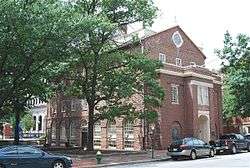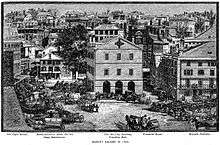Market House (Providence, Rhode Island)
The Market House is an historic three-story brick market house in Market Square, in the College Hill neighborhood of Providence, Rhode Island, USA. The building was constructed in 1775[1] to a design by locally prominent architect Joseph Brown and Declaration signer Stephen Hopkins.[1][3] The bottom level of the structure was used as a market and the upper level was used for holding meetings in the tradition of English public market buildings. Similar buildings existed in other American cities, such as Faneuil Hall in Boston and the Old Brick Market in Newport. The building housed the Providence City Council in the decades before completion of City Hall.
Market House | |
U.S. National Historic Landmark District Contributing Property | |
 Market House in 2008 | |
  | |
| Location | Providence, Rhode Island |
|---|---|
| Coordinates | 41°49′32″N 71°24′31″W |
| Built | 1775[1] |
| Part of | College Hill Historic District (ID70000019) |
| NRHP reference No. | 72000001[2] |
| Significant dates | |
| Added to NRHP | April 13, 1972 |
| Designated NHLDCP | November 10, 1970 |
Architecture
The primary architect was Joseph Brown. Brown was Providence's top architect at the time.[1] His previous commissions included University Hall at Brown University and the First Baptist Meeting House.[1] He was assisted in his design by Stephen Hopkins.[1]
The building was originally two stories in height, topped by a low gable roof.[1] In 1797, a third floor was added to house the first Masonic Lodge in Rhode Island.[4] The first floor is surrounded on all sides but the eastern end by an arcade of large round arches. The east gable features a large bulls-eye window; the west gable, a clock.[1]
In 1833, architect James C. Bucklin designed a two-story addition on the east end of the building. This addition provided an entrance to the third story Masonic hall.[1]
History
In August 1771, a petition signed by a number of townspeople was presented to the General Assembly, asking for a market house. The General Assembly raised funds through a lottery to erect a building in a location proposed by David Bucklin. Excavations on Market House began on May 25, 1773[3] and was completed in 1775.[1]
Almost immediately, Market House became the center of civic life in Providence, due to its central location at the east end of the Weybosset Bridge. On March 2, 1775 residents gathered here to show their resistance to British taxation by burning British tea.[3]
During the American Revolution, the building was used as a barracks for French soldiers encamped in Providence.[3][5]
The building's third floor housed the first Masonic Lodge in Rhode Island.[4] Thomas Smith Webb was a member of the lodge, and in 1802 Webb organized St. John's Encampment Number One, which was the first Knights Templar organization in America.[5]

In 1832, Providence Mayor Samuel W. Bridgham[6] moved Providence City Council to meet in Market House.[3][4] At first, the City Council, Mayor's Office, and Board of Aldermen were located on the second floor. As the city grew, the city government purchased the third floor from the Masons, and eventually occupied the entire building, which was then renamed the "City Building."[4] By 1845 the city government outgrew the building and drew up plans to build a new City Hall. By 1878 the new City Hall was completed and the city vacated Market House.[4]
In the years after the city left the building, tenants included the Providence Board of Trade (later known as the Chamber of Commerce), the Henry Lippitt Company, several manufacturing companies, a barber, the Rhode Island Poultry Association, and the Rhode Island Electric Light Company. Market Square and Westminster Street were the first parts of Providence to receive electric street lights.[3]

The building underwent some restoration work in the 1930s, and by 1940 the building was restored to its 1833 appearance.[1] In 1948, Mayor Dennis J. Roberts signed a deed to give the building to the Rhode Island School of Design, with the provision that the exterior of the building be maintained.[3] Architect John Hutchins Cady was hired to remodel the interior with classrooms and studios.[3]
A pair of plaques on the exterior wall marks the highest water levels reached during the Great Storm of 1815 and the Hurricane of 1938.
The building was added to the National Register of Historic Places in 1972.[2]
References
- "NRHP nomination for Market House" (PDF). Rhode Island Preservation. Retrieved 2014-10-15.
- "National Register Information System". National Register of Historic Places. National Park Service. January 23, 2007.
- Cady, John Hutchins (October 1952). "The Providence Market House and its neighborhood" (PDF). Rhode Island History. Rhode Island Historical Society. 11 (4): 97–106. Retrieved 9 April 2015.
- Campbell, Paul. "A Brief History of Providence City Hall". City of Providence. Retrieved 9 April 2015.
- "Post Card Collection: Old Market House Market Square toward East end of Westminster St". Providence Public Library. PPL Rhode Island Image Collection. Retrieved 9 April 2015.
- "A Brief History of City Hall". City of Providence. Retrieved 9 April 2015.
External links
- Historic American Buildings Survey (HABS) No. RI-74, "Market House, Market Square, Providence, Providence County, RI", 9 photos, 3 data pages, supplemental material
- Cady, John Hutchins (October 1952). "The Providence Market House and its Neighborhood" (PDF). Rhode Island Historical Society. II (4): 97–117. Retrieved 6 July 2016.
| Wikimedia Commons has media related to Market House (Providence, Rhode Island). |